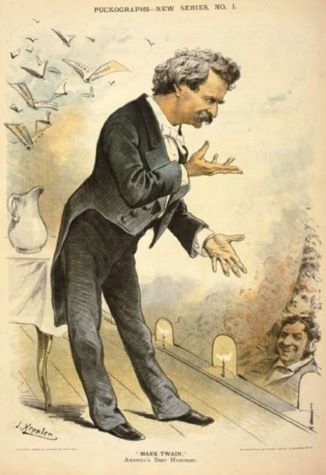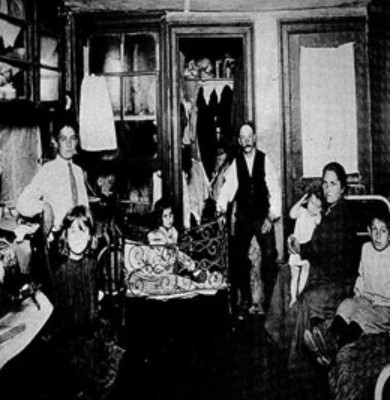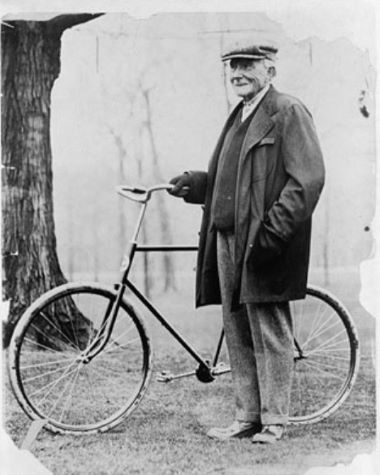

During the Gilded Age, the economic disparities between the workers and big business owners grew exponentially.
Introduction
From the 1870s to the 1890s, the United States entered a period of rapid industrialization. There was a shift from an agrarian economy to an industrial economy and many Americans began to move to urban areas. Mark Twain (depicted in the cartoon above) called this period the Gilded Age and criticized the era as a time of greed and political corruption.
Industrialization greatly increased the need for workers in the nation’s factories. The availability of factory jobs that required little or no skills was one of the reasons for a dramatic increase in immigration to the United States. Although working conditions in most factories were poor and unsafe, there was a steady stream of immigrant workers to fill the positions.

While there were millions of factory workers, the wealthy entrepreneurs who owned the factories represented a tiny fraction of Americans. The few wealthy controlled most of the wealth in the United States during this time.

During the Gilded Age, the economic disparities between the workers and big business owners grew exponentially. Workers continued to endure low wages and dangerous working conditions in order to make a living. Big business owners, however, enjoyed lavish lifestyles.
Economic Issues of the Gilded Age
The industrialization of the United States brought economic growth to the country like never before. The economy moved from agrarian to industrial; consumer goods were mass-produced and readily available. However, manufacturing was not the only industry that experienced growth. The railroad industry grew as the need to transport people and goods increased.

The rapid growth of the manufacturing industry created a great need for unskilled workers. This demand caused migration as farm workers moved from rural areas of the United States to find jobs in America’s rapidly growing cities. The increase in jobs was also a draw for people in foreign countries. Many people immigrated to the United States in search of work and the opportunity to live the American dream.
While industrialization led to an increase in jobs, it also led to poor working conditions for this new industrial labor force. Workers were forced to work in dangerous conditions surrounded by heavy machinery. Unskilled laborers required little training and completed routine tasks. They also worked long hours and were paid low wages.
Big business owners benefitted tremendously from the economic changes in the United States. Some historians have said that these entrepreneurs were robber barons because they got rich through ruthless means. Others have called them captains of industry because they were greatly responsible for increasing productivity, expanding markets, providing jobs, and increasing the nation’s wealth. Read below to learn more about a few of these business owners.

Andrew Carnegie is one of the most notable entrepreneurs of the Gilded Age. Carnegie, a native of Scotland, immigrated to the United States in 1848. The Carnegie family settled near Pittsburgh, Pennsylvania, where his father got a job in a cotton factory. Andrew also worked in the same factory as a bobbin boy. He made $1.20 per week.
Andrew Carnegie later worked as a messenger for a telegram company, a personal secretary, and other positions in Pennsylvania. Later, Carnegie went on to own companies in the railroad, bridge, and oil industries. His most successful business was his steel company, U.S. Steel. Carnegie amassed a fortune of more than $300 billion in today’s dollars; yet his workers had to endure low wages, long hours, and harsh working conditions.
Later in life, Carnegie became a philanthropist, donating the vast majority of his money to various groups; he established libraries and supported various colleges and universities.

J.P. Morgan was a U.S. banker. Born in Hartford, Connecticut, Morgan became one of the most famous financiers in the United States.
With his power and influence, Morgan successfully reorganized railroad companies that served the eastern half of the United States. He helped regulate the railroad rates, which in turn discouraged competition between the railroads. While reorganizing the railroads, he also controlled the stock of these companies. By 1900, Morgan was one of the most powerful railroad moguls in the world.
Morgan also worked on consolidating major industries. In 1898, he merged several steel corporations, including the one he bought from Andrew Carnegie, forming U.S. Steel Corporation. This became the world’s first billion dollar corporation.
Morgan’s banks controlled the financing for many industries in the United States, including shipping, railroad, and steel. Morgan was accused of creating monopolies in two industries in particular, railroad and steel. Morgan was so powerful that the U.S. government asked him for help out of a financial crisis in 1895, and again in 1907.

John D. Rockefeller was a prominent business owner in the oil industry. Rockefeller was born into a working-class American family. Early in life he worked various jobs, learning invaluable skills along the way.
In the 1860s, Rockefeller invested in the oil industry. He opened a refinery and later founded Standard Oil. Rockefeller then bought out smaller oil companies, thereby limiting competing oil companies. He convinced railroad companies to lower rates for his companies. Soon Rockefeller had created a monopoly in the oil and railroad industries.
Standard Oil became extremely profitable because of its monopolistic practices. Nevertheless, Rockefeller paid low wages to his workers. When workers protested or went on strike, Rockefeller would close a worksite, rather than pay higher wages.
Later in life, Rockefeller gave away half of his fortune, more than $500 million, to various causes.

In this cartoon, Standard Oil is portrayed as a menacing octopus whose tentacles are reaching toward various entities in American society.
Social Issues of the Gilded Age
Nativism

The photo above was taken in the early 1900s. What words would you use to describe the scene on this street? Overcrowded? Chaotic? Both terms may fit perfectly. The photo is of Hester Street, an open-air street market, where people could find all kinds of goods. The overcrowded streets are an indication of how much the urban population had grown as a result of the Gilded Age.
There were several social issues that plagued American society during the Gilded Age. Many of those issues were the result of increased immigration in the United States and the migration of Americans from rural areas to large cities. As word of new job opportunities in America spread to foreign countries, immigration rapidly increased. Most immigrants at this time came from southern and eastern Europe. Many immigrants also came from Ireland.
Typically, immigrants moved into areas that were populated by people of the same race or ethnicity. This led to the creation of ethnic neighborhoods. These ethnic neighborhoods could be found in cities such as New York City, Pittsburgh, or Chicago.
Not everyone had a positive attitude about immigrants coming to America. Many nativists felt that the flow of immigrants posed a threat to American society. Since the 1840s, nativists had embarked upon a campaign to protect the rights of native citizens of America against those of immigrants.
To spread their beliefs, nativists started a cartoon campaign to express their beliefs about immigration. The cartoon below, “Dumping European Garbage,” was a part of this campaign. Carefully analyze the cartoon and answer the questions that follow in your notes.

The Statue of Liberty was frequently used in the nativists’ cartoon campaign.
The combination of mass immigration to major U.S. cities and increased rural migration to urban areas led to rapid population growth in these areas. This urbanization caused a housing shortage, which made for overcrowded, poor living conditions for many people who moved into these areas.

To accommodate the overpopulation and influx of immigrants, people lived in tenements. These were sometimes former single-family apartments that were divided to provide space for multiple families. These buildings were overcrowded with poor ventilation and inadequate plumbing. The neighborhoods became unsanitary and some became slums.
Poor Working Conditions and Child Labor
During the Gilded Age, a growing number of Americans worked in urban areas in manufacturing factories. They worked 10-hour shifts, six days a week. The wages they earned were barely enough to support their families. Adults worked long and hard and sometimes they were injured as a result of their jobs. Those who were injured on the job, or otherwise unable to work, were simply replaced by another worker. There was little to no job protection for workers during this time.

Eventually, workers decided that these conditions were no longer tolerable. Realizing that laborers outnumbered owners, laborers began to organize and develop labor unions. Labor union members participated in strikes as a means to evoke change from the business owners.

Labor union members were met with intimidation and sometimes violent resistance from the bosses and owners. However, the reaction from the business owners did not deter the labor unions. The labor union movement grew slowly as members fought for safer working condition, higher wages, and shorter work hours.

Another issue that impacted the labor force was child labor. Children worked in factories, carrying out tasks that were sometimes extremely dangerous. Children, some as young as eight years old, went to work instead of attending school. They were often expected to do the same work as adults did, but for less pay.
Political Issues of the Gilded Age
Commerce and Anti-Trust
During the Gilded Age, the federal government experienced extreme difficulties. Congress had a reputation of being inefficient and prone to corruption. There was little legislation passed during this time. The federal government initially supported big businesses. However, the federal government later passed two crucial pieces of legislation that impacted the actions of big business owners in the United States. Read below to learn more about these acts.

“In 1887 Congress passed the Interstate Commerce Act, making the railroads the first industry subject to Federal regulation. Congress passed the law largely in response to public demand that railroad operations be regulated. The act also established a five-member enforcement board known as the Interstate Commerce Commission. In the years following the Civil War, railroads were privately owned and entirely unregulated. The railroad companies held a natural monopoly in the areas that only they serviced.”
The Interstate Commerce Act was the first step in regulating monopolies, but more enforcement was needed. In 1890, Congress passed the Sherman Anti-Trust Act.

“The Sherman Antitrust Act of 1890 was the first measure passed by the U.S. Congress to prohibit trusts . . . Several states had passed similar laws, but they were limited to intrastate businesses. The Sherman Antitrust Act was based on the constitutional power of Congress to regulate interstate commerce.”
Political Machines

The Senate controlled Congress, and big business owners heavily influenced senators. Government officials were easily bought, and they often traded political favors for bribes. Bribery and other acts of corruption did not stop at the federal level. Political machines controlled governments at the state and local levels. Political machines were organized political systems that traded jobs and other services in exchange for votes. A small group or a single boss controlled these political organizations.
Thomas Nast, a famous cartoonist, used cartoons to inform people about the political bosses and political machines. He frequently featured Boss Tweed. William Magear Tweed was a political boss in New York City who used jobs and favors to create a loyal voter base. Although he helped many immigrants, he did so through corruption.
Conclusion
The Gilded Age lasted from the 1870s through the 1890s. The United States was transitioning from an agricultural society to an industrial one. The Gilded Age impacted American society economically, socially, and politically. The Gilded Age was a time of great wealth for a few and poverty for many.
Originally published by the Texas Gateway for Online Resources, Texas Education Agency (TEA), to the public domain.






